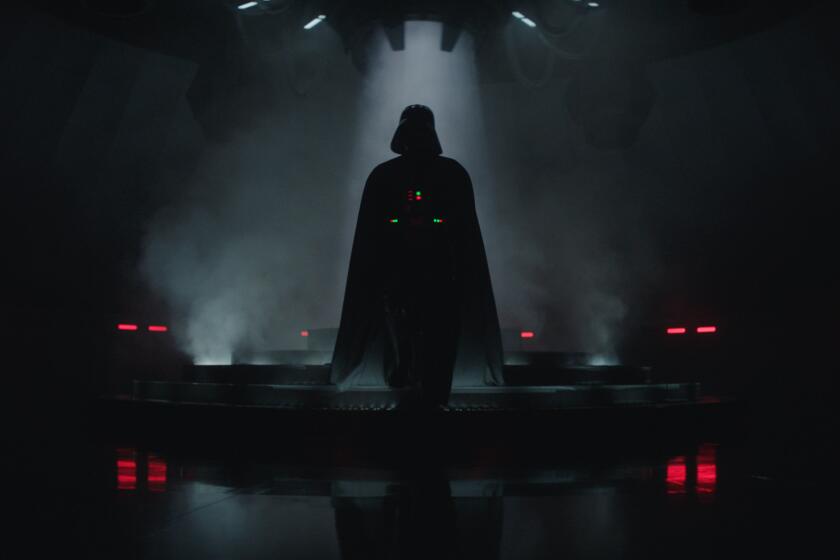Too soon to go to the beach? The gorgeous docu-game ‘Beyond Blue’ has deeper questions
- Share via
Here in Southern California, many of us are well aware of the allure of the Pacific.
And efforts aimed at stemming the spread of the coronavirus have put our beaches under a national spotlight. Over the past few weeks, debate over access to the Orange Country coastline has sparked protests and legal fights. Tuesday, some Southland beaches were set to begin phased reopenings, less than a week after Gov. Gavin Newsom placed them under a “hard close.”
But where some see a place for recreation — or a stress-relieving spot to refuel — others see a gateway to another world.
We had a recent reminder of this in late April when, under the night sky, a neon lilt took over parts of our coastline. Waves with a bioluminescent blue glow transfixed and inspired ocean enthusiasts to head to the coastline despite stay-at-home restrictions. The phenomenon — sometimes called sea sparkle — was associated with a red tide, or algae bloom, made up of organisms called dinoflagellates, and it made the Pacific look as if it were controlled by some form of sorcery.
Science, we are told in the video game “Beyond Blue” — and reminded of daily in our hunger for a COVID-19 vaccine — is not magic. But nature often conjures the illusion of magic. We only have to be open to seeing it, an act that often requires patience on our part, and the need to give the planet and its non-human inhabitants the space and time to breathe.
This has been the prevailing sensation I’ve had while playing “Beyond Blue,” an aquatic adventure that has us exploring a world that is largely unknown to most of us: the ocean. As we dig into the mysteries of a whale family in “Beyond Blue,” answers to questions the game raises aren’t found in some puzzle. We swim, we observe and we learn. Play is simply the act of unearthing information.
So although I’m fully committed to sheltering in place and will be avoiding trips to the beach for now, thanks to “Beyond Blue” I don’t necessarily feel I’m missing out. The game has made me curious about what lies far beyond the shore, below the reach of the sun. It’s given me pause, the desire to further uncover what I do not know rather than to retreat into places of real-world familiarity.
That’s because exploration in “Beyond Blue” is akin to being given a window into another culture. The game draws inspiration from nature documentaries and science — it’s made in collaboration with BBC Studios and with input from those behind “Blue Planet II” — but it also comes with its own optimistic near-future fiction.
More important, perhaps, is that one of the game’s prevailing themes is the simple message that we are not alone. In every mission of “Beyond Blue,” we guide a deep sea diver — Mirai, voiced by Anna Akana — into deeper depths as she researches sea life, including some thought to be near-extinct. She’s primarily tracking a pod of sperm whales, learning the habits of a young whale while also trying to downplay her concerns that this particular whale grouping has seen its numbers dwindle.
We asked game developers: What’s your go-to game in coronavirus quarantine? Makers behind ‘Doom Eternal,’ ‘The Last of Us’ ‘Watch Dogs,’ more answer
Despite Mirai’s occasional trepidation, her voice often has a hopeful uplift, and thus the underlying tone of “Beyond Blue” is comforting. The game is a reminder that we not only share this planet, but also that the waters we so often aim to frolic in don’t really belong to us. We are intruders, a not entirely unexpected conclusion.
Sometimes the glistening coral-like shapes I swim toward turn out to be deflated metallic-blue birthday balloons. But the world that the game wants to show is one of possibility, an underwater universe that isn’t polluted so much as one on the way to restoration.
And it’s gorgeous.
I’m impressed with the sense of wonder and awe that E-Line Media has brought throughout “Beyond Blue,” which is available now for Apple Arcade, the tech giant’s mobile subscription service, and will be coming the week of June 8 to home computers, the PlayStation 4 and the Xbox One.
Although it is our own world that “Beyond Blue” seeks to illuminate, from the get-go we feel as if we are venturing into something alien. Heck, I closed and restarted the app numerous times upon first booting it up because I heard a clicking noise and thought my tablet’s speakers were on the fritz. The sound was actually a sperm whale.
From there, “Beyond Blue” fully enchants.
After a short intro that features a cameo from “Avatar” filmmaker James Cameron — he’s working with “Blue Planet II” collaborators OceanX Media on a planned series to explore our oceans — we are introduced to the core gameplay tenets of “Beyond Blue.” We scan the ocean for signs of life, in this case the language of whales, dolphins, sharks and a bevy of other sea creatures, and set out to document how they survive. Or hunt. Or play. Mirai is streaming her exploits for an unseen online audience, who sometimes pepper her with questions that get the game to reveal some aquatic facts.
We’re accompanied by a small research team, one Mirai talks with but only rarely sees, and through these companions the game starts to explore the tensions between research endeavors and the competing missions of the corporations that sometimes fund them. A slight unease seeps into mid-dive scenes on a submarine base as the game raises niggling questions regarding the ultimate fate of our research. Yet these narrative-focused moments are not heavy-handed, as Mirai ‘s pure intentions are never in doubt and the goal of “Beyond Blue” is to stoke a sense of discovery rather than to lecture.
Here it succeeds. On the touch screens of Apple’s iOS devices, we use two hands, our left propelling Mirai through the ocean and our right providing more directional cues. It took a full mission to properly get my sea bearings. But even when I lost sight of a whale or dolphin I was trailing or trying to swim with, I wasn’t frustrated. “Beyond Blue,” while creating an inviting view of the ocean, also makes it clear that Mirai is an outsider here. She doesn’t speak the language, of course, of any of the animals she encounters, and is sometimes in the dark as to what sort of noise she is hunting down.
It should be noted that “Beyond Blue” is balancing a lot. This isn’t a metaphorical and lyrical exploration of the sea (for that, check out “Abzu”). “Beyond Blue,” like E-Line’s delightful folkloric game “Never Alone,” a journey into Native Alaskan culture, has aspirational qualities. I hesitate to use the word edu-tainment, as inspiring inquisitiveness about the world that surrounds us shouldn’t be written off as learning. But I would encourage players to dig into the supplemental material.
The more denizens of the sea we scan, the more we learn simple tidbits on how they live. We build essentially a Rolodex of animals, and can listen to whale songs or learn about how climate change is affecting turtle populations. This is also where the BBC partnership comes into play, with some 15 brief documentaries on topics ranging from the abilities of jellyfish to regenerate to mini biographies of oceanographers such as Sylvia Earle.
Ultimately, “Beyond Blue” is equally about reverence for the sea and our own invasive tendencies. Never is this more apparent than when we watch mammoth whales react to the the intrusive noises of man-made machinery, which reverberates through the ocean in ways that have punishing sonic effects on all life in the vicinity.
Consider it a gentle reminder that the ocean is someone else’s home, and sometimes we’d do well to stay in ours.
More to Read
The biggest entertainment stories
Get our big stories about Hollywood, film, television, music, arts, culture and more right in your inbox as soon as they publish.
You may occasionally receive promotional content from the Los Angeles Times.











